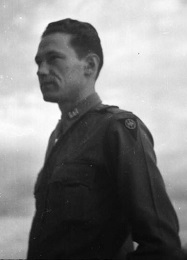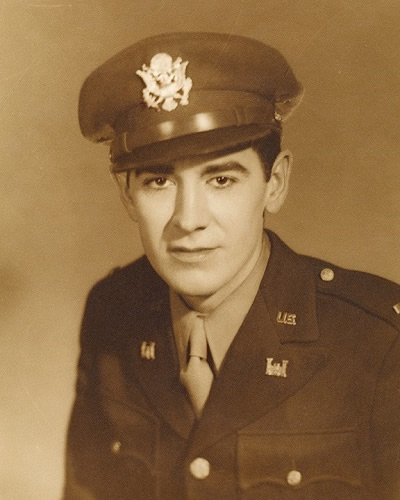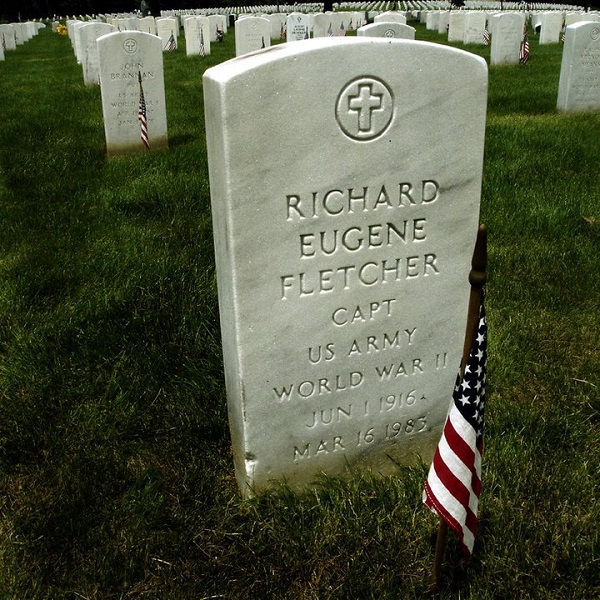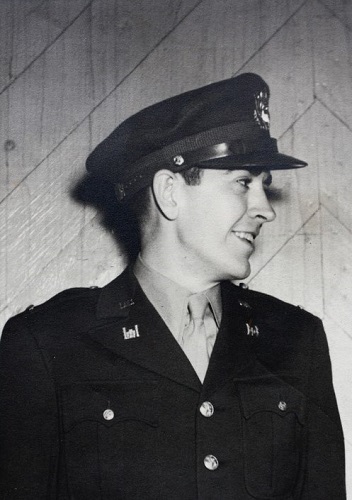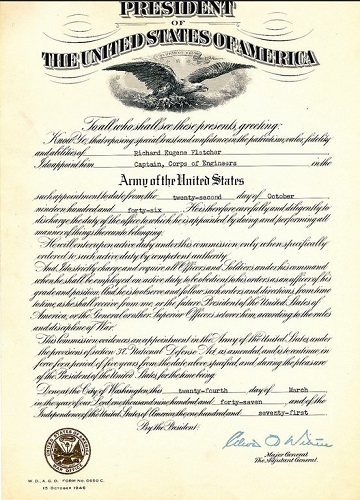In 1942, Rick’s art career was interrupted by World War II. He went to Camp Dodge, Iowa on September 29th 1942, then on to Officer Candidate School at Fort Belvoir, Virginia. He was commissioned in the Corp of Engineers, April, 1943 and Assigned as a First Lieutenant S-1 Adjutant to 308th Engineer Combat Battalion with the 83rd infantry Division. Rick went through five European military campaigns from D-Day +10 at Omaha Beach, the Battle of Normandy through the hedgerows zigzagging across France, into Belgium, Holland and fought in the Battle of the Bulge. He raced through the German Wehrmacht into Germany along with his 83rd Infantry Division when General Eisenhower ordered the Army to stop- he was in Zerbst, Germany just beyond the Elbe River approximately eighty-eight miles from the bunker where Hitler was hiding in Berlin. Two weeks later Hitler committed suicide in the bunker when the Russian Army invaded Berlin from the eastern front. At the end of the war until his trip back to the United States, Rick was assigned many duties, one as a Commanding Officer of the Sonndorf Prisoner of War Camp in Germany, another duty was Purchasing and Contracting Officer to build camps for Displaced Persons and Prisoners of War, plus assignments as a Trial Judge Advocate. During his military duty in Europe, Rick received the Bronze Star Medal for distinguishing himself by meritorious service in connection with military operations against an enemy of the United States. Aside from his regular duties in the U.S. Army, Rick hand lettered signs and painted vehicles. He passed time by drawing caricatures of himself expressing his moods in his letters home. Ricks methods of drawing with paper and pen became increasingly difficult as many supplies were scarce while overseas. Rick frequently relied on his 35mm Leica camera to produce quick convenient photographs throughout Europe; he took images of citizens, soldiers and landscapes, eventually making a photo scrapbook and a watercolor painting of Belgium peasants he had photographed from his jeep. Rick arrived home from Europe on January 1st, 1946. He was separated from service as a Captain on February 27th 1946. His name is inscribed in the Book of Honor at the Court of Patriots - Rock Island Arsenal Museum, located on the same property as the National Cemetery in Rock Island, Illinois where he is currently buried along with his wife Beverly.
After the war, Rick was offered a job at two locations, the Chicago Tribune and a local Chicago engraving studio. In a diary entry Rick decided to choose the Tribune because “I just liked walking down Michigan Avenue and going into the Tribune Tower, which has quite a mystique in Chicago”. Rick joined the advertising art department in April 1946 handling illustrations and cartooning. Rick studied for several years under personal supervision of Carey Orr, Pulitzer Prize winning Chief Editorial Cartoonist; learning advanced comic strip technique. Carey Orr taught many illustrators, including (then high school student) Walt Disney in 1917. Tribune colleagues took notice of Rick’s work which showed quality and versatility. While he worked in the advertising department Rick continued to pursue opportunities in illustration by submitting original samples of his collaborative work to editors at the Chicago Tribune. “The Old Glory Story” was Rick’s first weekly syndicated full color adventure story strip starting on February 15th 1953. Brilliantly created, written and researched by Athena Robbins, This timely multi-award winning story strip guided readers through the history of the American Flag. The unique aspect of The Old Glory Story was the attention to detail with all the stories, flags, people, uniforms, weapons and transportation which were illustrated and produced with historical accuracy then reproduced in full color every week until April 17th 1966.
Meanwhile, back in 1961, while working on Old Glory at the Crossroads, an opportunity arose from another artist at the Chicago Tribune. Chester Gould, the creator of Dick Tracy, had a position open when his young assistant Dick Locher had to resign. . Rick was thrilled with the opportunity to illustrate another world class Strip. His duties included penciling panels, illustration, inking backgrounds, advertising composition and layout, as well as developing story lines. During the spring of 1962 Gould hired Rick on a full-time basis to be part of the Dick Tracy production team which at the time included Chester Gould’s brother, Ray for lettering; Jack Ryan for production art and Chicago Police Detective Al Valenis for police related research.
Rick concurrently worked on The Old Glory Story and Dick Tracy from 1961 until the last Old Glory strip finished April 17th 1966. Rick performed on Chester Gould’s Dick Tracy comic strip production team continuously for 16 years, learning Gould’s unique drawing and story style Rick called “Gouldism”. This experience and an already award winning illustration career led Tribune executives and Chester Gould to unanimously agree to have Rick Fletcher take over production of Dick Tracy when Gould retired on December 25th, 1977.
Working with a young new writer, Max Allen Collins, Rick began flexing his abilities by equipping Tracy with state of the art equipment: a nickel plated Colt Trooper MKIII .357 magnum revolver with illuminated night-sights and the famous 2-way wrist TV (which Rick created with his younger brother Ed in 1963 at a family Christmas party) Rick illustrated the Dick Tracy comic strip for five productive years, always researching the latest technologies, current trends in popular culture and the opinions of his fans. Rick utilized proper law enforcement techniques and procedures learned from several of his friends in law enforcement: from the Dakota County Minnesota Sheriff’s Office, Julio Santiago, other friends working at the Federal Bureau of Investigation and his old friend Al Valenis from the Chicago Police Department. Contributing time and talent to his local community in Woodstock, Illinois, Rick produced several illustrations for fund raising auctions, as well as personal cards for friends in the hospital. On several occasions Rick would acknowledge friends and family by using their name or likeness hidden somewhere in the background of the story panels, then gave them the original art as a gift.
Rick Fletcher was employed with the Chicago Tribune from early 1946 until cancer took his life on March 16th, 1983. Described as the "world’s greatest artist of guns, hardware and machinery in the history of comic strips" and having hundreds of millions of readers around the globe.
Richard Eugene Fletcher died at age 67 on March 16, 1983, and is buried at the Rock Island National Cemetery on an island in the Mississippi River at Rock Island, Illinois. |
